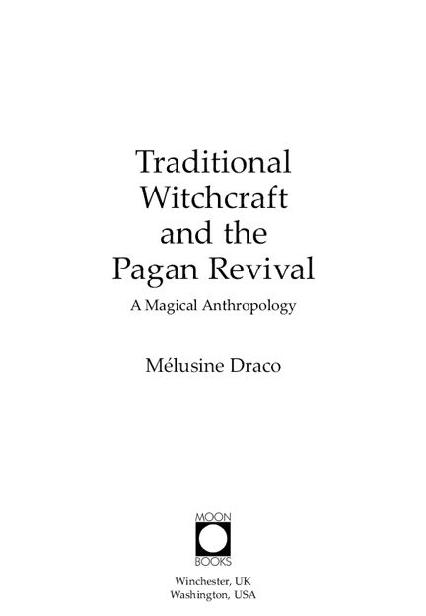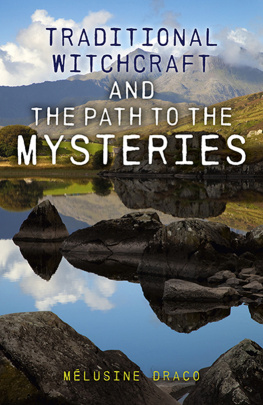Melusine Draco - Traditional Witchcraft and the Pagan Revival: A Magical Anthropology
Here you can read online Melusine Draco - Traditional Witchcraft and the Pagan Revival: A Magical Anthropology full text of the book (entire story) in english for free. Download pdf and epub, get meaning, cover and reviews about this ebook. year: 2013, publisher: Moon Books, genre: Religion. Description of the work, (preface) as well as reviews are available. Best literature library LitArk.com created for fans of good reading and offers a wide selection of genres:
Romance novel
Science fiction
Adventure
Detective
Science
History
Home and family
Prose
Art
Politics
Computer
Non-fiction
Religion
Business
Children
Humor
Choose a favorite category and find really read worthwhile books. Enjoy immersion in the world of imagination, feel the emotions of the characters or learn something new for yourself, make an fascinating discovery.

- Book:Traditional Witchcraft and the Pagan Revival: A Magical Anthropology
- Author:
- Publisher:Moon Books
- Genre:
- Year:2013
- Rating:3 / 5
- Favourites:Add to favourites
- Your mark:
- 60
- 1
- 2
- 3
- 4
- 5
Traditional Witchcraft and the Pagan Revival: A Magical Anthropology: summary, description and annotation
We offer to read an annotation, description, summary or preface (depends on what the author of the book "Traditional Witchcraft and the Pagan Revival: A Magical Anthropology" wrote himself). If you haven't found the necessary information about the book — write in the comments, we will try to find it.
Traditional Witchcraft and the Pagan Revival: A Magical Anthropology — read online for free the complete book (whole text) full work
Below is the text of the book, divided by pages. System saving the place of the last page read, allows you to conveniently read the book "Traditional Witchcraft and the Pagan Revival: A Magical Anthropology" online for free, without having to search again every time where you left off. Put a bookmark, and you can go to the page where you finished reading at any time.
Font size:
Interval:
Bookmark:

First published by Moon Books, 2013
Moon Books is an imprint of John Hunt Publishing Ltd., Laurel House, Station Approach,
Alresford, Hants, SO24 9JH, UK
www.johnhuntpublishing.com
www.moon-books.net
For distributor details and how to order please visit the Ordering section on our website.
Text copyright: Mlusine Draco 2013
ISBN: 978 1 78279 156 0
All rights reserved. Except for brief quotations in critical articles or reviews, no part of this book may be reproduced in any manner without prior written permission from the publishers.
The rights of Mlusine Draco as author have been asserted in accordance with the Copyright,
Designs and Patents Act 1988.
A CIP catalogue record for this book is available from the British Library.
Design: Stuart Davies
Printed and bound by CPI Group (UK) Ltd, Croydon, CR0 4YY
We operate a distinctive and ethical publishing philosophy in all areas of our business, from our global network of authors to production and worldwide distribution.
Chapter titles from music by George Henry Crumb, USA
Dedicated to Alan Richardson and Michael Howard who keep everyones feet firmly on the ground
Mlusine Draco originally trained in the magical arts of traditional British Old Craft with Bob and Mrim Clay-Egerton. She has been a magical and spiritual instructor for over 20 years with Arcanum and the Temple of Khem, and writer of numerous popular books on magic and witchcraft. Her highly individualistic teaching methods and writing draw on ancient sources, supported by academic texts and current archaeological findings. www.covenofthescales.com.
Her Traditional Witchcraft series is published by Moon Books (an imprint of John Hunt Publishing): Traditional Witchcraft for Urban Living, Traditional Witchcraft for the Seashore, Traditional Witchcraft for Fields and Hedgerows and Traditional Witchcraft for Woods and Forests. Traditional Witchcraft and Modern Paganism is the fifth book in the series. The Dictionary of Mystery & Magic, By Spellbook & Candle and Magic Crystals, Sacred Stones (Axis Mundi) are also available from John Hunt Publishing imprints.
The aim of Traditional Witchcraft and the Pagan Revival is to provide a sympathetic approach to the evolution of witchcraft as a historical reality, rather than as mere circumspection or wishful thinking. By combining scholarly writing and recent archaeological findings with a quality of fascination, I hope it will prove to be a delight to read and a source of new insight for those who would follow the traditions of the Old Ways. It shows that witchcraft did (and does) exist, and traces the origins and true nature of the many different contemporary pagan beliefs back to their roots. And, what is equally as important, to understand when outside foreign influences were grafted onto indigenous pagan stock.
Generally speaking, todays paganism falls into four different elements, which in turn separate the different approaches and levels of magical practice. A considerable amount of magical writing can be incomprehensible to those who have not been schooled in that particular path or tradition so we begin at the beginning and work ourselves up through the spheres of Knowledge, Wisdom and Understanding. And we start by accepting that there is a divide between the various approaches to paganism and magical practice. Such as:
Animistic: The belief that everything animate and inanimate has its own life-force, such as that which forms the basis of shamanism and Old Craft;
Eclectic: Selecting or borrowing from a variety of styles, systems, theories, beliefs, etc., as commonly found in modern paganism and Wicca;
Syncretic: The attempt to reconcile different systems of belief; the fusion or blending of religions, as by identification of gods, taking over of observances, or selection of whatever seems best in each; often producing a seemingly illogical compromise in belief. Found in many aspects of Western Ritual Magic, and the initiatory branches of tradi- tional witchcraft;
Synergetic: Combined or co-ordinated action; increased effect of two elements obtained by using them together. The combining of ancient wisdom with modern magical applications, as in the case of the contemporary approaches of Old Craft, Norse (Heathen) and Druidry.
As I observed in Coven of the Scales: The Collected Writings of A R Clay-Egerton, it should be understood that although Bob and Mrim Clay-Egerton firmly held the philosophy and opinion that all faiths were one, and that all paths led to the same goal, they did not advocate what is now referred to as eclectic paganism. What they did teach was the desire for knowledge and experience, regardless of source. Each new experience was studied within the confines of that particular religion, path or tradition. Each discipline was kept completely separate from another. Only when a student had a thorough understanding of the tenets of each discipline were they encouraged to formulate them into their own individual system.
These sentiments were echoed by Dion Fortune in The Mystical Qabalah:
No student will ever make any progress in spiritual development who flits from system to system; first using some New Thought affirmations, then some Yoga breathing-exercises and meditation-postures, and following these by an attempt at the mystical methods of prayer. Each of these systems has its value, but that value can only be realised if the system is carried out in its entirety the student who sets out to be an eclectic before he has made himself an expert will never be anything more than a dabbler.
This book invites the reader to take the opportunity to step back in time and discover through the gateways of intuition and instinct where their own individual roots can be found. Mlusine Draco Winter Solstice 2012
Echoes of Time and the River (Prologue)
One of the most striking features of the history of all religion is the way in which people have clung to the holy places of their far-off ancestors. It appears that once a site was sanctified through worship, an incoming people whether aggressive invaders, or the peaceful missionaries, gained prestige by occupying the site. When this was done, the old religion could be overthrown and the area purified with new ritual and religious observance.
Readers Digest, Folklore, Myths and Legends of Britain
When we read about ancestral British paganism today, more often than not, it is tinged with the rosy hue of the noble savage and wishful thinking, rather than based on progressive archaeological or anthropological discovery. For the first half-million years after our pre-human ancestors slowly morphed into a recognisable form, they were still primitives who left relatively little evidence of their existence except for a few bones and Palaeolithic tools. The emergence from the hunter-gatherer era to the development of agriculture, the domestication of animals, pottery and weaving, is a mere 10,000 years ago; while civilisation as we understand it, only dates back some 5,000 years.
Unfortunately, in the rush to establish the many different forms of 20th century revivalist paganism, the element of curiosity has often been suppressed in favour of historical ignorance. Anything that is non-Christian in origin is immediately embraced as pagan, despite the fact that much of it had little to do with the indigenous people of the British Isles. It also leads to the acceptance of fakelore and fantasy as the basis for a considerable amount of contemporary thinking. Reviewing one of these pseudo-history books in
Font size:
Interval:
Bookmark:
Similar books «Traditional Witchcraft and the Pagan Revival: A Magical Anthropology»
Look at similar books to Traditional Witchcraft and the Pagan Revival: A Magical Anthropology. We have selected literature similar in name and meaning in the hope of providing readers with more options to find new, interesting, not yet read works.
Discussion, reviews of the book Traditional Witchcraft and the Pagan Revival: A Magical Anthropology and just readers' own opinions. Leave your comments, write what you think about the work, its meaning or the main characters. Specify what exactly you liked and what you didn't like, and why you think so.


